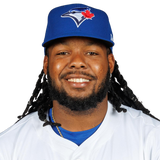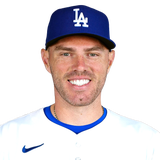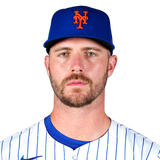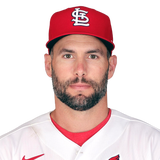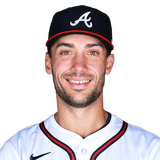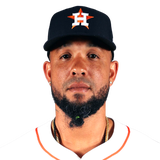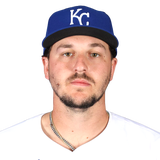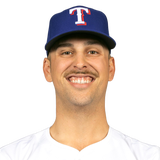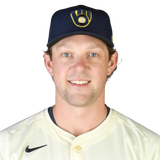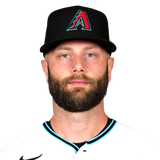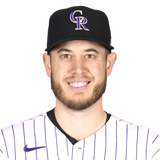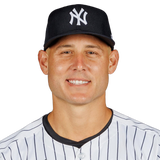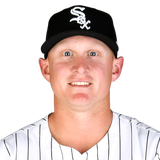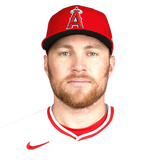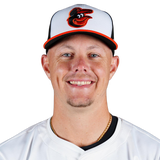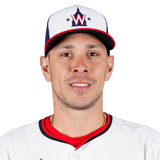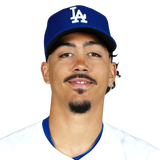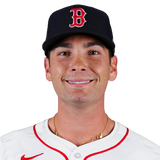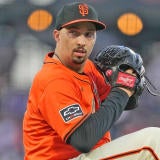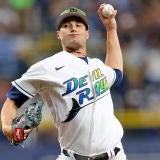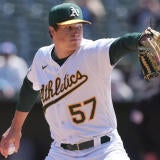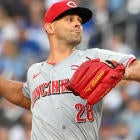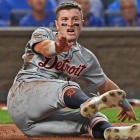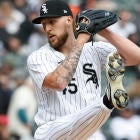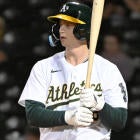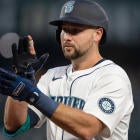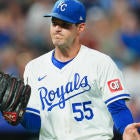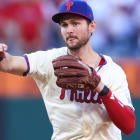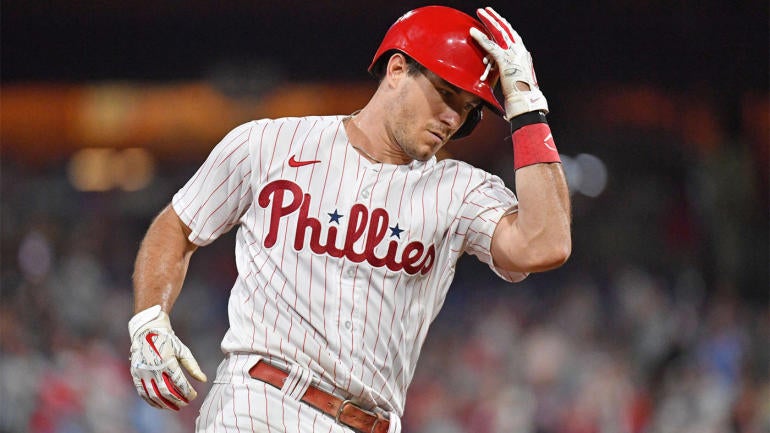
In some ways, 2022 was kind of a flop for the first base position in Fantasy Baseball. Looking back at last year's ADP for the position, there aren't a lot of success stories. Among the 12 highest drafted first baseman this time last year, only four are being drafted higher this year: Freddie Freeman (18.21 ADP in '22 to 12.97 in '23), Paul Goldschmidt (48.78 to 24.8), Pete Alonso (48.85 to 19.16), and Rhys Hoskins (123.98 to 120.35).
Guys like Jared Walsh (392.7 ADP in '23) and DJ LeMahieu (244.54) have seen their prices completely collapse, while Vladimir Guerrero (11.77) disappointed coming off his breakout season, while Jose Abreu has fallen from inside of the top-80 to nearly falling out of the top 100 (92.4), and Ryan Mountcastle has gone from a 10th-rounder to more like a 13th.
But it wasn't all bad. Goldschmidt had an incredible season that isn't quite reflected in his going price, while Vinnie Pasquantino (92.9) and Nathaniel Lowe (101.5) took huge steps forward and look like they could be big-time contributors moving forward. I'm not a huge believer in Lowe – his breakout was fueled by a more aggressive approach at the plate, and I worry pitchers will respond by throwing fewer pitches for him to hit – but still, he's a relatively young, talented hitter with some upside. Something this position desperately needs.

Fantasy Baseball Draft Kit
Your ultimate baseball draft guide
Dominate your Fantasy Baseball draft with our free Draft Kit, which gives you must-have positional and Top 300 rankings in a printable format. Plus track your draft with our lineup builder and salary cap tracker.
Thanks for signing up!
Keep an eye on your inbox.
Sorry!
There was an error processing your subscription.
The question is whether any other young players at the position are likely to take a similar step forward. We've got guys like Andrew Vaughn (137.55) and Jose Miranda (153.24) who could conceivably break out, though I like the former more than the latter. And then you've got Rowdy Tellez (162.3), who could improve thanks to the shift ban, and … then you kind of run out of reliable options with real upside.
That's the state of the position right now. The hope comes from the likes of Spencer Torkelson (304.6), Triston Casas (231.7), Matt Mervis (371.1) and a few other young prospect types who have some upside. If a few of those guys turn out the way Pasquantino did last year, first base could be formidable again.
Right now, we're kind of in between eras.
Guerrero took a pretty big step backwards last season, mostly because he couldn't sustain the gains he made as a power hitter from 2021. Still, he hit .274 with 32 homers and 187 combined runs and RBI, so it's hard to complain too much about what you got out of him – or, at least, it'll be hard to complain about that kind of production when you aren't spending a first overall pick on him. He won't cost that much this year, but the upside is still there if he gets back to elevating the ball; if he doesn't, he's still a strong four-category contributor.
| ||||||||||||||||||||||
Freddie Freeman is a metronome. He's been in the top 10% of the league in batting average, on-base percentage, and slugging percentage seven straight seasons now, and you know you're going to get elite production from him in multiple categories every year. He's 33, so there's some risk of age-related decline, plus you probably won't get elite home run production from him, but Freeman is about as strong a five-category contributor you'll find at first base.
| ||||||||||||||||||||||
Alonso is kind of a one-trick pony, but that is not meant as an insult, because it's a really good trick. Basically, he hits home runs with as much frequency as basically anyone in baseball, and he does it as consistently as anyone in baseball. In his four seasons, he's never finished worse than 13th in baseball in homers, and he's been top-10 in three of four seasons. That comes along with huge RBI numbers and a batting average that tends to help more than it hurts, too.
| ||||||||||||||||||||||
We've been about ready to write Goldschmidt off multiple times in his career, and every time he seems to make an adjustment that keeps him among the elite players in the game. Last season was actually one of his best, and while it's hard to keep pulling it off in your mid-(now late-)30s, Goldschmidt has done it so far. There's a risk that the dropoff will come at some point, that's baked into the price and then some at this point.
| ||||||||||||||||||||||
If you can't get Alonso, Olson is a pretty good contingency plan. He's a bit more of an all-or-nothing hitter than Alonso, but you can feel pretty confident you're going to get 35 or so homers and good run production numbers, albeit with both a lower floor and more risk in terms of batting average. If you can live with that, Olson is a pretty great option – and it's not unreasonable to think he could be in line for a bounceback season after changing leagues for the first time last season, a move that often requires an adjustment period.
| ||||||||||||||||||||||
The weirdest thing about Abreu's 2022 was that he had just 75 RBI in 157 games, as he's been one of the most consistent sources of that stat since he entered the majors – that was just the second time he hasn't been on a 100-RBI pace in a full season. The 36-year-old is clearly on the back nine of his career, and he might be pretty close to the 18th hole at this point. But the fact that a smart Astros team gave him a three-year contract should be a vote of confidence, and I'd be surprised if we didn't see him get back to that 100-RBI mark in this lineup.
| ||||||||||||||||||||||
Pasquantino had a solid rookie season that could have been even better with a bit better luck. He hit the ball consistently hard, in the air, and to the pull side of the field, which probably should have led to more than 10 homers – Statcast had him down for 15 expected homers even in a tough home park like Kauffman. I've got more to say about Pasquantino shortly, but to keep it brief: Draft him.
| ||||||||||||||||||||||
Lowe took a big step forward last season, though it's not really clear what he did differently than the previous season. He hit the ball in the air a bit more often, but not dramatically so; he struck out a bit less often, though again, it wasn't a significant improvement. Small, across-the-board improvements can lead to big results, though it also might highlight how thin the margin for error here. If Lowe can sustain it, improvement in his run production could take his Fantasy game to another level, too.
| ||||||||||||||||||||||
Hoskins never turned into the elite power hitter we thought he might be when he was younger, but he has established himself as a pretty consistent 30-ish homer hitter with room to hope for 35 or even 40 in a best-case scenario. The run production numbers are usually a bit disappointing, but otherwise there probably isn't that much separating him and someone like Olson.
| ||||||||||||||||||||||
The question with Walker is whether he can turn his second-half breakout into a full season's worth of production. He hit for power all season, but his .285 average after the All-Star break took his game to another level. His expected average (.257) suggests that's probably a bit too much to ask, but if he can just settle in around there, there may not be much difference between him and, again, someone like Olson.
| ||||||||||||||||||||||
If he didn't play half his games in Coors Field, there might not be too much to get excited about with Cron. And anytime a player is that dependent on their home park, there's always some risk of a trade tanking their value – especially on a team like the Rockies that doesn't figure to compete, with a veteran player like Cron. Still, he should remain a solid starting option as long as he's there.
| ||||||||||||||||||||||
The 32 homers from Rizzo last season were nice, but the run production and batting average left a lot to be desired. Playing his home games in Yankee Stadium should help Rizzo keep grinding out the homers, but he really doesn't do much else at this point, so he's definitely a fallback option at the position.
| ||||||||||||||||||||||
Vaughn makes a lot of contact (17% strikeout rate), and the contact he makes tends to be pretty loud (82nd percentile average exit velocity, 90th percentile hard-hit rate), which is what you're looking for. Now, he just has to start hitting the ball in the air with authority a little more often. There's no guarantee he will, but it's a skill set worth betting on given that it's really the only improvement he needs to make. If he does, the upside could be significant.
| ||||||||||||||||||||||
Drury stumbled upon getting traded to the Padres last season, going from hitting .274/.335/.520 with the Reds to just a .238/.290/.435 line with the Padres. Great American Ballpark is a fantastic hitting environment, and Drury surely benefited from it, but it's also worth pointing out that Angel Stadium is a lot closer to Cincy in park factors than Petco was. Does that mean Drury is going to repeat what he did in the first half of last season? Not necessarily, but at his current price, he doesn't have to. He can be a useful corner infielder at 80% of that production.
| ||||||||||||||||||||||
Mountcastle took a big step forward last season, just like many hoped he would, only you didn't notice because the Orioles turned Camden Yards into a cavern where dreams and fly balls go to die. Mountcastle's expected wOBA jumped up from .326 in 2021 to .362 in 2022, but his actual wOBA fell from .335 to .316 – that's what happens when you move basically the entire left field fence back 30 feet. Though, I will point out that Mountcastle was actually quite a bit better at home than on the road (a 77-point OPS gap), and if he can close that gap (or even, as you might expect, perform better on the road), he could still take a big step forward. It's not a guarantee, but it's not a bad roll of the dice.
| ||||||||||||||||||||||
I'm pretty skeptical of Meneses' big 2022, but anyone who hits .324/.367/.563 in the majors deserves a spotlight, even in a 56-game sample size. Meneses' underlying metrics don't quite support his surface level numbers, but they aren't bad – a 91.4 mph average exit velocity and below-average strikeout rate are especially impressive. It's unreasonable to think he could support a .900-plus OPS, but he is a career .295/.346/.494 hitter at Triple-A, so something in the .800 range isn't entirely unreasonable. With an ADP around 200, there are worse risks to take.
| ||||||||||||||||||||||
I have some concerns about whether Vargas is going to hit for much power at the major-league level, but that's about the only concern here. You probably won't end up using him much at first base, seeing as he's expected to earn eligibility at the shallower third base and second base positions, but positional flexibility is never a bad thing. And Vargas' speed (94th percentile sprint speed, 17 steals last season) could make him especially useful as an out-of-position source of steals with flexibility. He should be a good source of batting average thanks to his contact skills and is an ideal player to target for your CI spot.
| ||||||||||||||||||||||
Casas hit just .197 in his cup of coffee last season, but there are some positives to take away from it. He had five homers in his 27 games and walked a whopping 20% of the time, showcasing pop and plate discipline to build on. His 24% strikeout rate was a little elevated, but not so much that you should project him to flirt with the Mendoza line moving forward. It wasn't all perfect, of course – when you hit .197, things are rarely perfect – and Casas' quality-of-contact metrics weren't as impressive as you would've hoped, with his max exit velocity topping out at a good-not-great 110.5 mph. Still, the scouting reports suggest the raw power is there, and he seems pretty much guaranteed to be on the Red Sox Opening Day roster, so I'm willing to take a late-round bet on him.
| ||||||||||||||||||||||
Pasquantino had a very good rookie season, hitting .295/.383/.450, and he might have left a little meat on the bones. He had basically a one-to-one walk to strikeout ratio plus strong quality-of-contact metrics and a pull-heavy approach that should help him maximize his power. He won't run as much, but Pasquantino really gives me young Anthony Rizzo vibes as a hitter – and Rizzo was usually an early-round pick in his prime. You'll take that.
| ||||||||||||||||||||||
Lowe strikes me as aggressively fine. He's not bad by any means, I just don't think he's a difference maker – mostly because I don't see him replicating last year's success. He overperformed his expected stats pretty much across the board, with an expected batting average 27 points lower than his actual mark. I think he's probably more like a .270 hitter with 25 homers, and even that isn't exactly the floor – remember, he hit .264/.357/.415 and was pretty much a Fantasy afterthought in 2021. I think there's a decent chance he regresses back to that level and is a waste of a top-100 pick.
| ||||||||||||||||||||||
First Base Top Prospects
1. Miguel Vargas, 1B, Dodgers
Age (on opening day): 23
Where he played in 2022: Triple-A, majors
Minor-league stats: .304 BA (438 AB), 17 HR, 16 SB, .915 OPS, 71 BB, 76 K
Major-league stats: .170 BA (47 AB), 1 HR, 1 2B, 1 SB, 2 BB, 13 K
While there's little disagreement over Vargas' floor, which is bolstered by a hit tool that's seen him bat .300 or better up and down the minors, some have questioned whether his power is the sort that can anchor a lineup. The main reason for such nitpicking, though, is his unclear defensive home, with third base, second base and left field all still being in play.
Scott's 2023 Fantasy impact: fighting this spring.
2. Triston Casas, 1B, Red Sox
Age (on opening day): 23
Where he played in 2022: Rookie, Triple-A, majors
Minor-league stats: .281 BA (278 AB), 12 HR, .889 OPS, 49 BB, 70 K
Major-league stats: .197 BA (76 AB), 5 HR, .766 OPS, 19 BB, 23 K
Casas earned lofty comparisons to players like Freddie Freeman and Joey Votto during his minor-league climb, and while the production may not have always measured up, in part because of injuries, the talent was apparent in a late-season trial. He's an on-base freak with the sort of opposite-field power that should play well at Fenway Park with the Green Monster in left.
Scott's 2023 Fantasy impact: pencil him in
3. Tyler Soderstrom, 1B, Athletics
Age (on opening day): 21
Where he played in 2022: High-A, Double-A, Triple-A
Minor-league stats: .267 BA (505 AB), 29 HR, .825 OPS, 40 BB, 145 K
The Athletics haven't given up on Soderstrom as a catcher, but he played primarily first base last year. If it gets him to the majors sooner (and in the lineup more often), we'll take it. His numbers were suppressed early on by a hand injury and some cold weather in Lansing, Mich., but he hit .283 with an .865 OPS from May 1 on.
Scott's 2023 Fantasy impact: midseason hopeful
4. Matt Mervis, 1B, Cubs
Age (on opening day): 24
Where he played in 2022: High-A, Double-A, Triple-A
Minor-league stats: .309 BA (512 AB), 36 HR, 40 2B, .984 OPS, 50 BB, 107 K
Mervis went from being a total no-name to the minor-league leader in total bases last season, dominating at every stop with a shortened swing that yielded surprisingly low strikeout rates for a power hitter. The Cubs think they have another Anthony Rizzo on their hands and seem content to hand Mervis the keys to first base this spring, bringing in Eric Hosmer mainly as a contingency measure.
Scott's 2023 Fantasy impact: fighting this spring
5. Kyle Manzardo, 1B, Rays
Age (on opening day): 22
Where he played in 2022: High-A, Double-A
Minor-league stats: .327 BA (324 AB), 22 HR, 1.043 OPS, 59 BB, 65 K
Since being drafted in the second round two years ago, all Manzardo has done is hit .330 with a 1.043 OPS, maintaining the same level of production across three levels. The exit velocity readings are merely so-so, but he puts the ball where it needs to be for maximum damage. Only problem is he has a narrow defensive path in an organization that values lineup flexibility.
Scott's 2023 Fantasy impact: midseason hopeful


